Tuesday, October 24, 2006
Berlin, Germany, 15 Oct 2006: Jewish Museum
Soaring Planes And Searing Angles
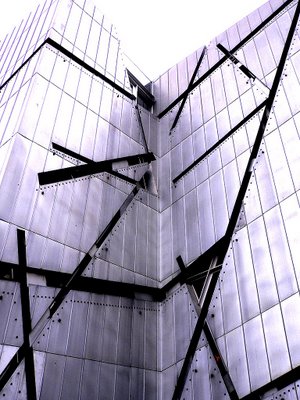 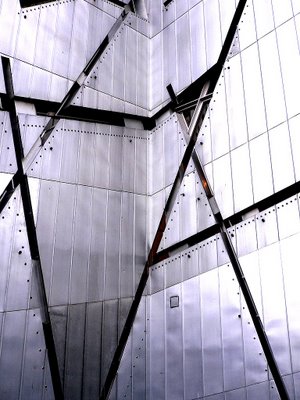 |
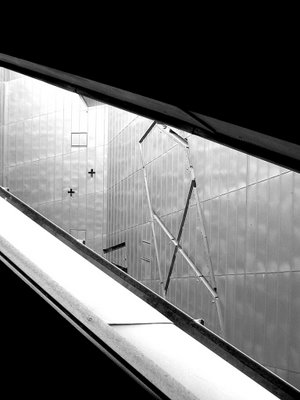 Berlin's Jewish Museum, designed by Daniel Libeskind, is a dizzying construct of geometric forms and sharp edges. Adjoining walls, floors or ceilings seldom, if ever, meet at right angles. Rather the surfaces collide at angles off the perpendicular, conspiring to deceive the eye and the mind, inducing a curious state of mildly vertiginous disorientation, "This is level ground I am standing on, is it not?" Berlin's Jewish Museum, designed by Daniel Libeskind, is a dizzying construct of geometric forms and sharp edges. Adjoining walls, floors or ceilings seldom, if ever, meet at right angles. Rather the surfaces collide at angles off the perpendicular, conspiring to deceive the eye and the mind, inducing a curious state of mildly vertiginous disorientation, "This is level ground I am standing on, is it not?"Clad in titanium-zinc plates, the building's imposing exterior is razor-slashed with clinical ferocity. Open lancinating wounds, intersecting narrow slits of window, let in austere shafts of light. The effect is complete. One is immediately seized and held hostage, overwhelmed by the raw power, stark vision and unnerving strangeness of the architecture. |
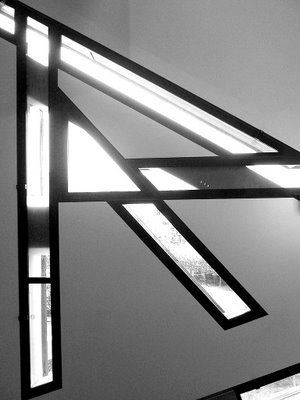 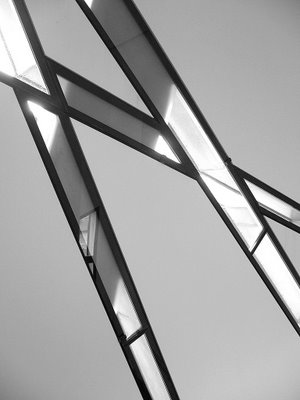 |
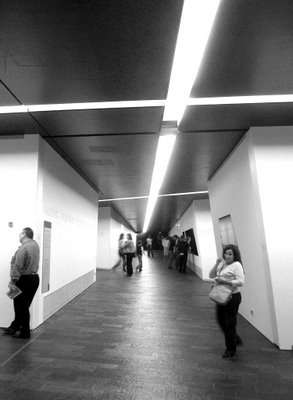 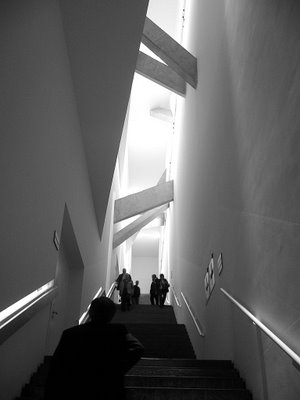 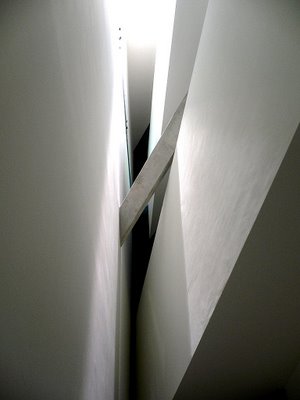 |
Enter the museum via an underground passage from the baroque building next door. Three axes - Axis of Continuity, Axis of Exile, Axis of Death - lie at the foundation of the museum. Walk along the first and climb up a long flight of stairs - overhung by perilous slanting ceiling beams that appear about to tumble down any moment - to reach the permanent exhibit. The main building is skewered by a series of interconnecting void spaces that, desolate and impenetrable, are visible only through narrow glass windows cut into the wall at intervals.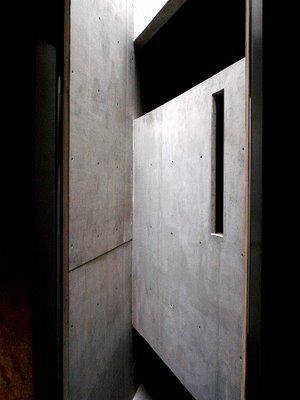 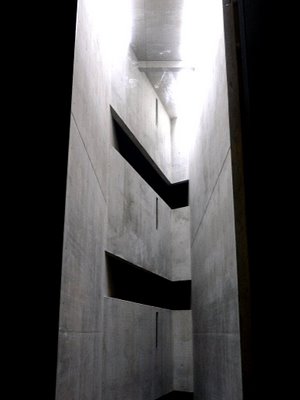 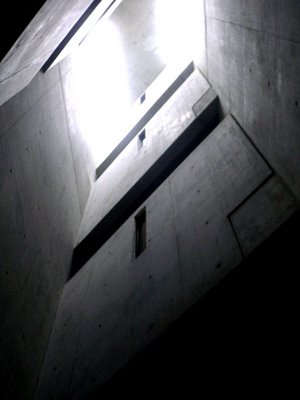 |
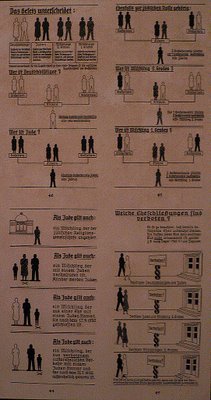 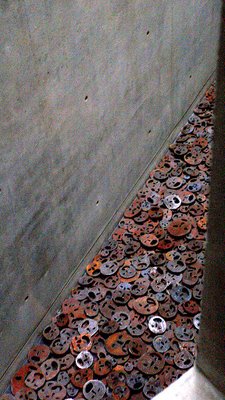 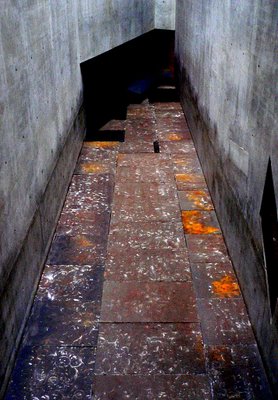 |
| The museum traces the two-thousand-year history of Jews in Germany, and documents their intellectual and cultural contributions. Racial hatred and discrimination, always beneath the surface, raised their ugly heads during the Nazi era. Jewish persecution began with racial laws in the 1930s. Geneology, abtrusely abused, marked Jews and half-Jews from the Aryan race. Miscegenation was verboten. The Holocaust erupted. In one of the void spaces, on the floor, thousands of metal discs resembling human faces - terror-stricken eyes wide open and mouth agape - look up at us: a deafening collective scream. In another, the faces are now gone; their imprints, a patina on the haunted silent ground. |
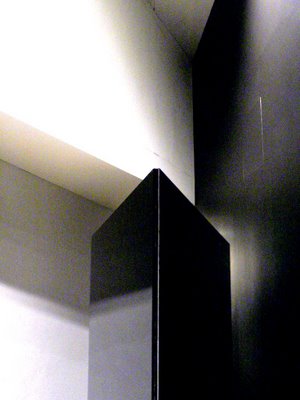 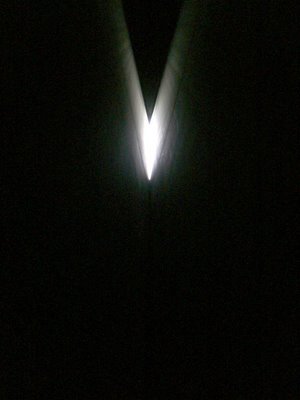 |
| Tall wedged-shaped black granite walls stand at various locations in the exhibition area. Strap on the special headphones. Go very near to the wall to hear the commentary. Nose almost touching the wall, Jerusalem's Wailing Wall comes to mind. Exit the exhibition. Walk along the undergound Axis of Death. At the end, enter the Holocaust Tower, a few at a time. Total isolation, sensory deprivation and cold fear close in. The confined bare concrete space is totally dark, except for light piercing a tiny aperture near the ceiling: the light and its reflection form a shining V, a vestige of hope. |
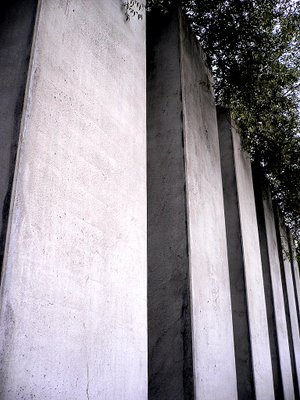 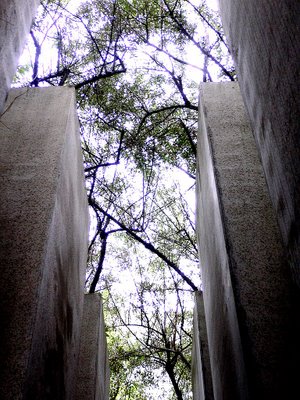 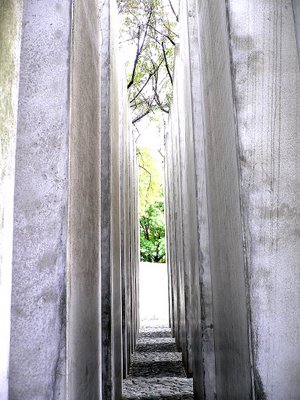 |
Finally, go along the Axis of Exile. Names of cities absorbing the Jewish Diaspora line the walls of the corridor. Push open the rhomboid door at the end and step gingerly - the ground slopes off the horizontal - into the Garden of Exile. Forty-nine concrete stelae, or pillars, stand erect in a grid on a small square set below ground level. On the tops of all except one, plants thrive on Berlin soil. On the last stele, soil from Jerusalem has been symbolically laid. 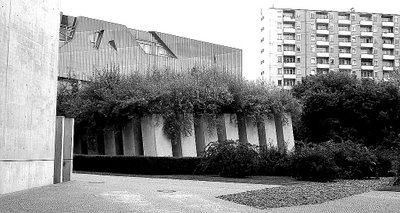 |
Labels: architecture, art, Berlin, Germany, history, museum, religious site
Saturday, October 21, 2006
Berlin, Germany, 11-15 Oct 2006: Gemaldegalerie Paintings
Ladies Of A Certain Vintage
West Berlin's Gemaldegalerie has a remarkable collection  of early Netherlandish and Italian Renaissance paintings. Achingly vivid depiction of of early Netherlandish and Italian Renaissance paintings. Achingly vivid depiction of 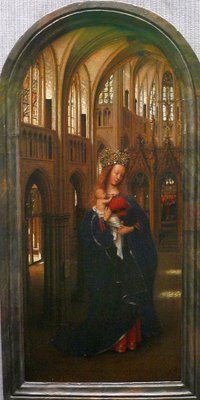 Woman is a major thematic cord that binds religious and secular art. Woman is a major thematic cord that binds religious and secular art.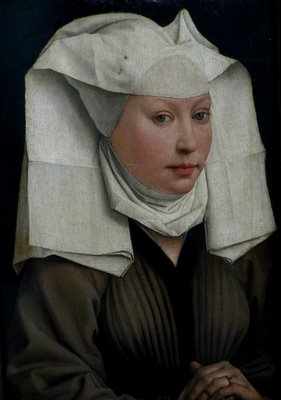 In Madonna in the Church by Jan van Eyck, a larger-than-life Mary stands inside an intricately etched church interior, cradling the infant Jesus in her arms. A supernatural amber aura emanates from, and transfigures, the central figures. Rogier van der Weyden, van Eyck's contemporary and equal, imbued his subjects with unparalleled emotional depth and intensity that was revolutionary in his time. Woman Wearing a Gauze Headdress conveys with delicate sensitivity a Flemish noblewoman's demure confidence. The white gauze headdress, primly pinned into place, is a tour-de-force of finely woven details, translucency and textures. Petrus Christus' masterpiece Portrait of a Young Girl enthralls with the subject's petulant half-smile and detached gaze, drawing one to wonder, "Who is she?" |
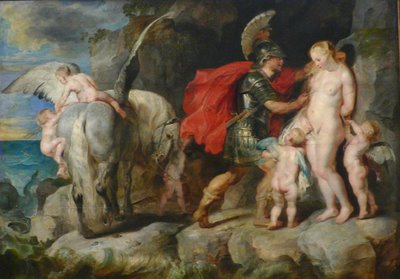 Peter Paul Rubens reenacted the Greek myth of Perseus Freeing Andromeda from certain ravage by the seamonster, to whom she has been sacrificed, with dramatic free brush strokes and luscious colours. She glows, nude, bowing in gratitude, as he, incarnadine cape furiously flapping, rushes forward. Peter Paul Rubens reenacted the Greek myth of Perseus Freeing Andromeda from certain ravage by the seamonster, to whom she has been sacrificed, with dramatic free brush strokes and luscious colours. She glows, nude, bowing in gratitude, as he, incarnadine cape furiously flapping, rushes forward.More contemplative and sedate are Jan Vermeer's works. A magician at creating myriad light effects, his leitmotif is of scenes of everyday life set in rooms lit by natural light filtering in through open windows. The Woman With a Pearl Necklace holds her necklace carefully to the light, admiring its reflection in the mirror. In The Glass of Wine, we are voyeurs of the secret love life of the couple: witnessing the precise moment that temperance succumbs to indiscretion as wine trickles from the glass into her quivering hitherto chaste lips. 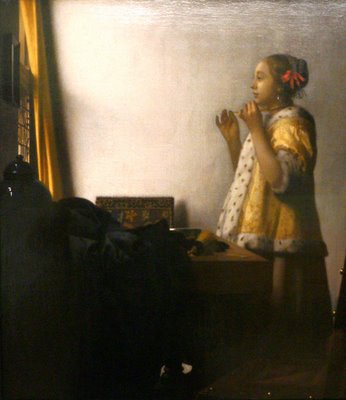 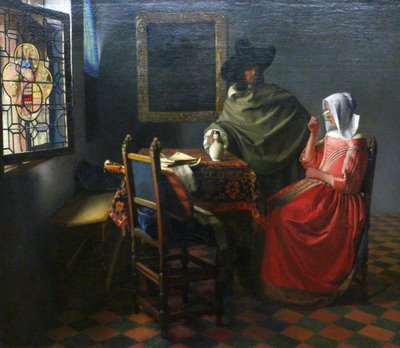 |
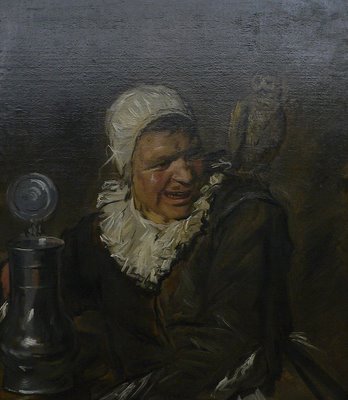 Frans Hals' Portrait of Malle Babbe incisively captures the crude sneering laugh of tavern proprietress 'Mad Babbette' aka 'The Witch of Haarlem'. An owl perched precariously on her left shoulder, she gruffly twists her thick torso around to countenance her Frans Hals' Portrait of Malle Babbe incisively captures the crude sneering laugh of tavern proprietress 'Mad Babbette' aka 'The Witch of Haarlem'. An owl perched precariously on her left shoulder, she gruffly twists her thick torso around to countenance her 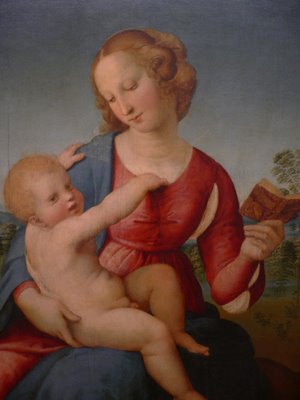 customers with choice curses, giving as good as she gets. customers with choice curses, giving as good as she gets.The Dutchman Hal's restricted dark palette and grimy realism contrast sharply with the luminous pastels and ethereal beauty of the Italian Raffaello Sanzio's Colonna Madonna (begun by Raffaello, completed by Ridolfo Ghirlandaio). Here, Mary's fresh-faced buxom country maiden fondly gazes at and quietly adores baby Jesus seated on her lap. He playfully clutches her decolletage, looking at us, grinning. The taut outstretched right arm artfully connects the holy duo compositionally. |
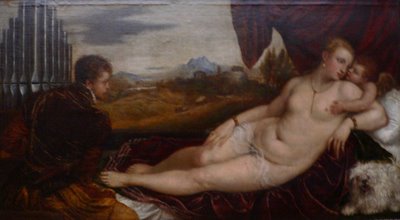 Tiziano Vecellio painted four works of Venus with musicians, allegories to Love, Music's Muse. In Venus and the Organ Player, she is object of the latter's ogling. She, cool to his infatuation, is alas unattainable. Tiziano Vecellio painted four works of Venus with musicians, allegories to Love, Music's Muse. In Venus and the Organ Player, she is object of the latter's ogling. She, cool to his infatuation, is alas unattainable.Inspired by Botticelli's similar painting, Piero di Cosimo's delightful Venus, Mars and Cupid shows Venus and her lover Mars in an idyllic landscape, the latter exhausted and spread out in deep post-coital slumber. Mars is utterly vanquished, his armour is in disarray; his arms, cherubs' toys. Feted by her son Cupid and a white rabbit, symbol of fecundity, supreme Venus presides over her spoils. Love conquers all. 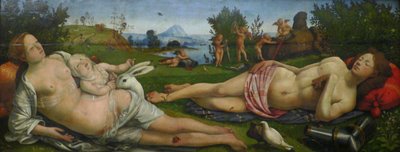 |
Labels: Berlin, Germany, ladies, museum, painting
Wednesday, October 18, 2006
Berlin, Germany, 11-15 Oct 2006: Ägyptisches Museum
Berlin's Most Beautiful Woman
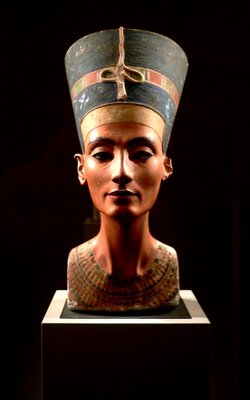 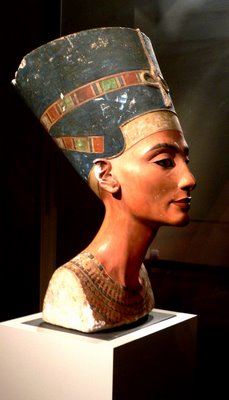 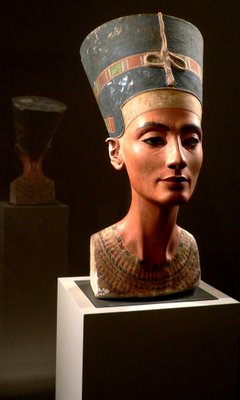 The painted plaster bust of Queen Nefertiti is the jewel of Berlin's Egyptian Collection, currently housed on the upper floor of the Altes Museum. The classic lines of the heavy 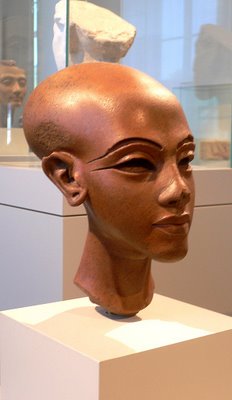 flat-topped crown sitting on the head supported by a sleek elongated neck, the deep vibrant colours, and the life-like portrayal of the ageless face, faintly lined at the outer edges of the lips and below the eyes, seem almost modern. Immediately, one senses the palpable tautness of the neck muscles and the regal serenity of her enigmatic one-eyed gaze. Unlike the right eye which possesses a dark crystal pupil, the left was left strangely unadorned. The bust was never complete, but instead probably used as a model in the studio of her great sculptor-creator Thutmose, where she was discovered unperturbed more than 3000 years later in Amarna. flat-topped crown sitting on the head supported by a sleek elongated neck, the deep vibrant colours, and the life-like portrayal of the ageless face, faintly lined at the outer edges of the lips and below the eyes, seem almost modern. Immediately, one senses the palpable tautness of the neck muscles and the regal serenity of her enigmatic one-eyed gaze. Unlike the right eye which possesses a dark crystal pupil, the left was left strangely unadorned. The bust was never complete, but instead probably used as a model in the studio of her great sculptor-creator Thutmose, where she was discovered unperturbed more than 3000 years later in Amarna.Look also at other sculptures of Nefertiti in the museum. This one to the left reveals a youthful Nefertiti with somewhat more filled-out cheeks and a perfectly-shaped cranium. Another shows her more mature, standing with haunched shoulders, breasts drooping over a nascent middle-age paunch. In all these depictions, her person and unmistakable humanness transcend millennia to reach out to, grab and touch us. |
Labels: art, Berlin, Germany, ladies, museum, sculpture

Licensed under Creative Commons Attribution-NonCommercial-NoDerivs 2.5 License

These are the 30 countries that I have ever set foot on. Airport stopovers don't count!
